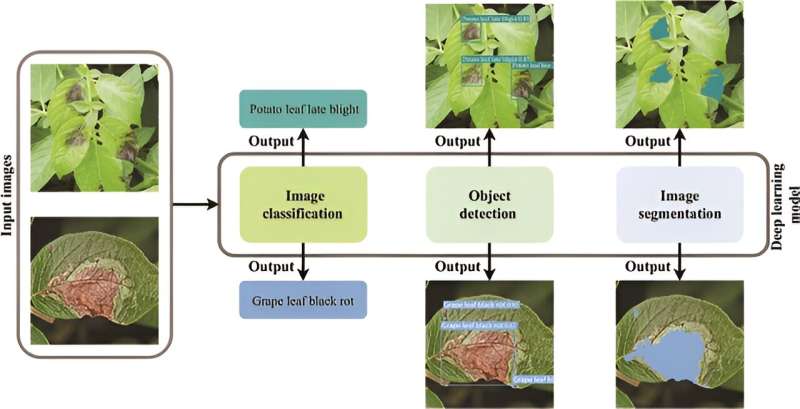This article has been reviewed according to Science X's editorial process and policies. Editors have highlighted the following attributes while ensuring the content's credibility:
fact-checked
trusted source
proofread
Novel lightweight deep learning models unveiled for multi-crop protection and plant disease diagnosis

Swift plant disease diagnosis is vital to prevent extensive production losses and uphold food security. Recently, object detection-based methods using deep learning have shown promise in accurately identifying and locating crop diseases.
However, these methods currently face limitations as they are generally restricted to diagnosing diseases in single crops and entail a high computational load due to their extensive parameter requirements. This poses challenges in deploying these models on agricultural mobile devices, as reducing parameters often leads to decreased accuracy.
Therefore, there's a need for research to balance model efficiency and accuracy, aiming for lightweight yet effective models capable of diagnosing multiple diseases across various crops.
In June 2023, Plant Phenomics published a research article titled "Knowledge Distillation Facilitates the Lightweight and Efficient Plant Diseases Detection Model ."
In this study, researchers introduced a novel lightweight and efficient method for plant disease diagnosis using object detection across multiple crops. The approach employs knowledge distillation, focusing on multistage knowledge distillation (MSKD) to enhance lightweight student models through a comprehensive teacher model.
The study was based on the PlantDoc dataset and utilized various hyperparameters and data cleaning to improve model accuracy. The student models, including YOLOR-Light and Mobile-YOLOR variants, were compared with both traditional and the latest image object detection methods. These models demonstrated superior performance in terms of parameters, computational requirements, and memory usage, while maintaining comparable accuracy.
The effectiveness of the MSKD method was confirmed by comparing distilled models with non-distilled ones, demonstrating significant improvements in mean average precision (mAP).
Visualization analysis using Eigen-CAM revealed that the student models, post-distillation, allocated attention more effectively, enhancing disease localization and classification. The ablation study further established the efficacy of distillation on different parts of the student models, emphasizing the head stage distiller's role in learning spatial information and diversity of plant disease categories.
The study also evaluated the models' lightweight nature, crucial for real-world agricultural applications.
The YOLOR-Light-v2 model emerged as a balanced choice, striking a harmony between lightweight and accuracy. The initial values of object boxes were also examined, highlighting the importance of dataset-specific knowledge for precise lesion localization.
In summary, this comprehensive study not only advances plant disease diagnosis using object detection but also opens avenues for addressing broader challenges in agricultural image processing.
More information: Qianding Huang et al, Knowledge Distillation Facilitates the Lightweight and Efficient Plant Diseases Detection Model, Plant Phenomics (2023). DOI: 10.34133/plantphenomics.0062
Provided by NanJing Agricultural University




















